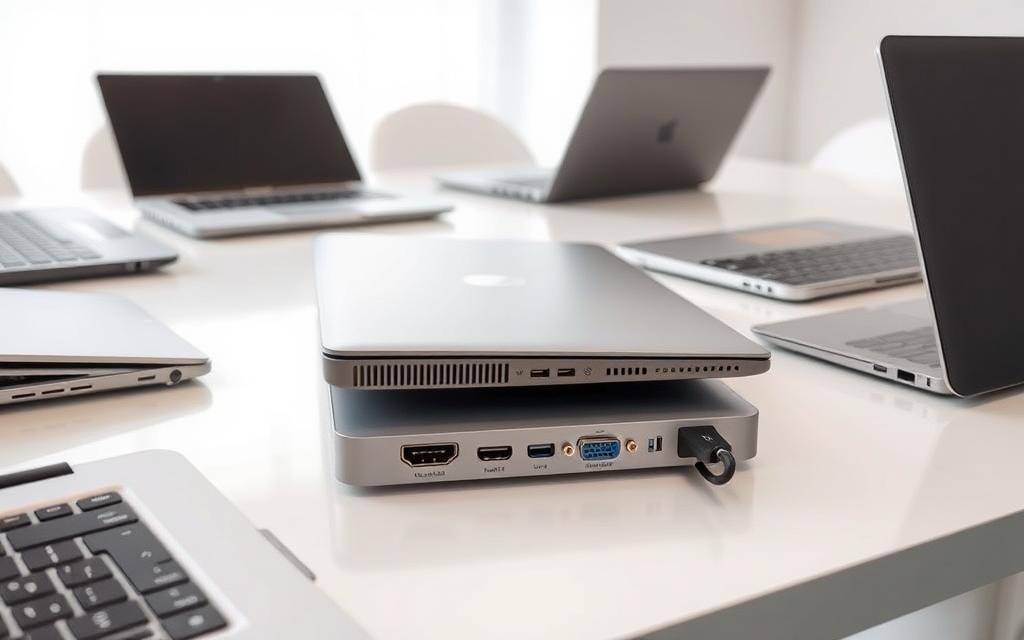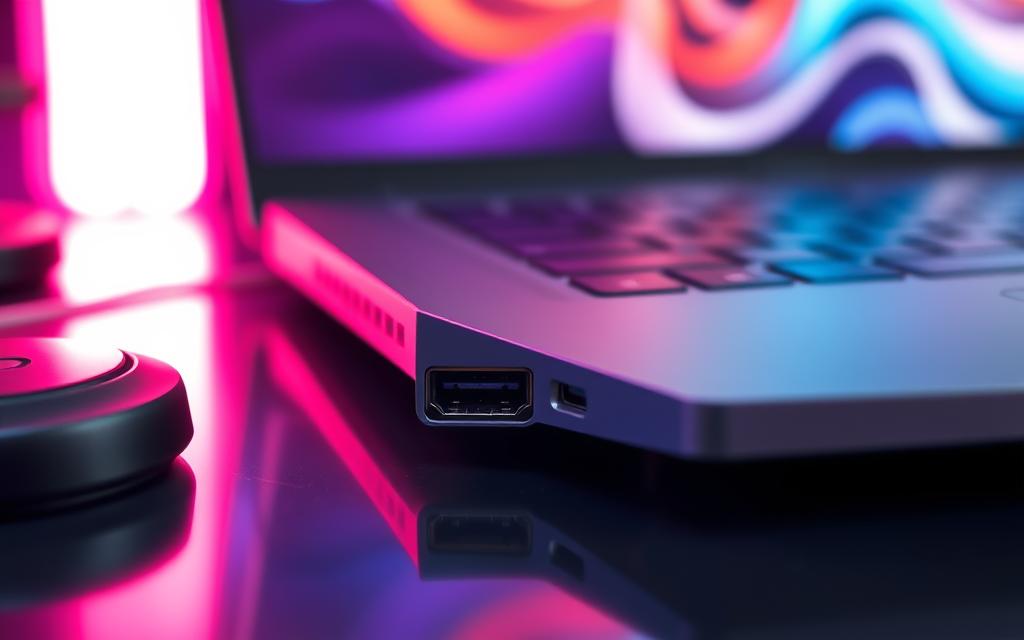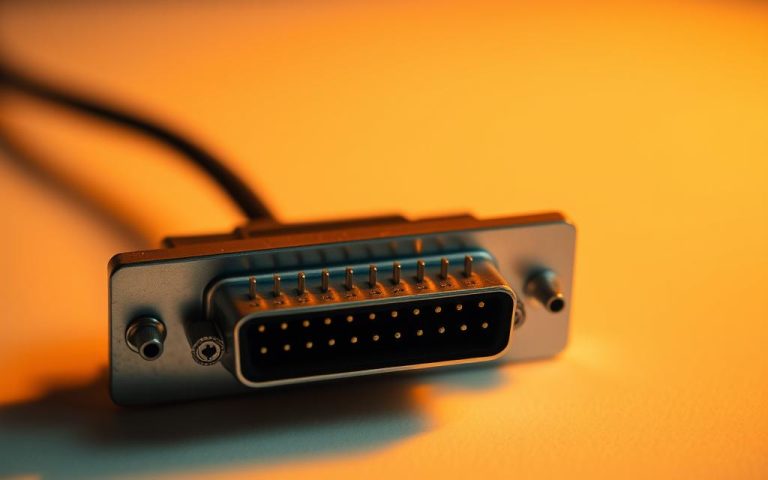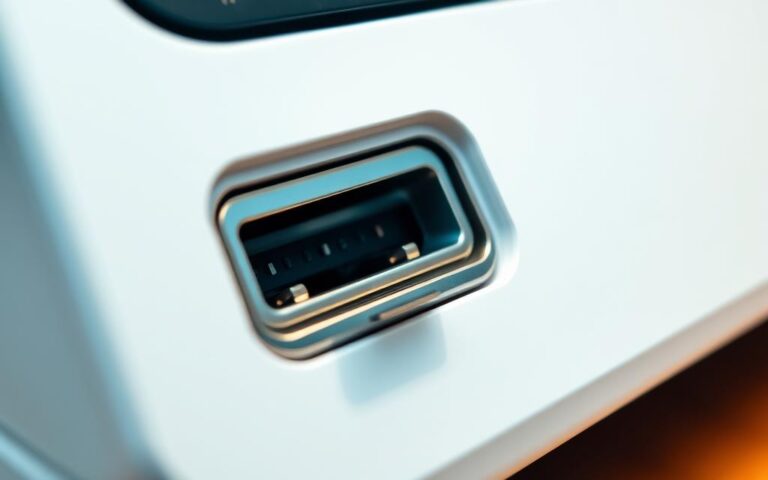Do Laptops Include a DisplayPort?
Technology keeps advancing, making it vital to know about laptop connection features. Many ask, do laptops have a DisplayPort? We’re diving into the importance of DisplayPort tech in today’s tech world. For those into gaming or graphic design, having strong connection options like DisplayPort matters. Let’s see if modern laptops commonly have this feature.
To learn more about DisplayPort technology, let’s note that as laptops progress, so do their visual performance capabilities. We’ll delve deeper into DisplayPort’s role in the latest tech soon.
Understanding DisplayPort Technology
DisplayPort technology links computers to monitors. It shows clear advantages for high-resolution tasks. Latest versions provide amazing capabilities for top performance needs. This tech is perfect for gaming and graphics work. Let’s explore DisplayPort, its benefits, and how it compares to HDMI.
What is DisplayPort?
DisplayPort is a digital interface. It’s designed to connect computers to screens. It supports high resolutions and fast refresh rates. This makes it great for gaming and design. The technology also lets you connect many monitors. DisplayPort 2.1 offers the newest features.
Benefits of Using DisplayPort
DisplayPort has many key benefits. These include:
- Supporting very high resolutions, up to 8K at 60Hz with newer versions.
- The ability to connect several displays with one output, making setups easier.
- High refresh rates, with DisplayPort 1.4 allowing 4K at 120Hz and multiple displays at 2,560 x 1,600 at 60Hz.
- It works with Adaptive Sync to make gaming smoother.
Comparison with HDMI
DisplayPort vs HDMI shows both have unique features. HDMI is more common in home electronics like TVs. DisplayPort is better for high-end computing, offering:
| Feature | DisplayPort | HDMI |
|---|---|---|
| Max Resolution | 8K at 60Hz | 4K at 60Hz (HDMI 2.0) |
| Daisy-Chaining | Yes | No |
| Adaptive Sync | Supported | Limited Support |
| Common Use | Computers and Monitors | Televisions and Media Devices |
Choosing between DisplayPort and HDMI depends on user needs. With strong features, DisplayPort is key for the best visual performance.
Do Laptops Have a DisplayPort?
The laptop design trends have changed a lot lately, especially about the ports they offer. Many companies now choose a simpler look, which means fewer ports. This change makes people wonder if you can still find DisplayPort available laptops.
Current Trends in Laptop Design
Nowadays, laptops often come with USB-C and HDMI rather than DisplayPort. This makes DisplayPort laptops rare. Most thin laptops and cheaper models don’t have a DisplayPort. This is because brands want to make laptops that are easy to carry. This might not suit everyone, especially if you need to connect to several screens or need very clear images.
Models with DisplayPort Functionality
Despite this, some laptops still offer DisplayPort. This is common in business-class laptops and top gaming ones. These laptops are for people who need good screen quality. The HP ProBook and Framework laptops are good examples. They support DisplayPort well, letting you hook up to several high-quality screens. Framework laptops even let you use one DisplayPort for up to four displays, which is great for people who need lots of screens.
Common Alternatives to DisplayPort on Laptops
In today’s laptop world, we’ve got lots of ways to connect. Besides DisplayPort, HDMI and USB-C are top choices for linking laptops to screens. Knowing about these options can make using external displays a breeze.
HDMI Ports on Laptops
HDMI ports are a go-to for hooking laptops up with different devices. They work with TVs, monitors, and projectors without a fuss. Thanks to HDMI, laptops can send video and sound over one cable, making things tidier.
HDMI’s newer versions, like 2.0 and 2.1, offer amazing picture quality. They’re great for the latest display demands. Here’s what they provide:
| HDMI Version | Max Resolution | Refresh Rate |
|---|---|---|
| HDMI 1.4 | 4K at 30Hz | 1080p at 120Hz |
| HDMI 2.0 | 4K at 60Hz | N/A |
| HDMI 2.1 | 10K at 120Hz | N/A |
HDMI suits both media fans and gamers. It’s still widely used, even with new tech around.
USB-C as an Alternative Connection
USB-C is making a splash in the laptop scene. It’s versatile, handling data, power, and video in one go. Some USB-C ports even have DisplayPort features, making them a great stand-in for direct DisplayPort connections.
With the shift towards sleeker laptops, USB-C offers major pluses:
- Portability: Its small size means sleeker laptops.
- Multifunctionality: One port does it all, reducing mess.
- Future-proofing: It’s becoming the standard, keeping up with tech changes.
Why Some Laptops Still Lack DisplayPort
Laptop design has changed because people want light, easy-to-carry devices. Since portability is key, some connections like DisplayPort get left out. This is because not everyone thinks they need it for daily tasks.
Market Demands and Consumer Preferences
What people want has a big say in what laptops offer. Many like slim laptops. So, companies make laptops that are easy to carry but might not have DisplayPort. They think simple is better for everyday use, which influences what features are included.
The Impact of Cost on Design Choices
Adding different ports can make laptops more expensive to make. To keep prices down, some brands skip parts like DisplayPort. This makes the laptops cheaper. It helps reach those who don’t want to spend a lot and don’t need all the extra ports.

Use Cases for DisplayPort in Laptops
DisplayPort technology is now common in modern laptops. It enhances how we use our devices in different ways. It’s very important for gaming and crucial for laptops used in graphic design.
Gaming and High-Performance Visuals
For gamers, DisplayPort is a big deal. It supports fast refresh rates and high resolutions. This means games look smooth and detailed, greatly improving gameplay. Low input lag also gives players an advantage in fast-paced games.
Professional Applications in Graphic Design
Graphic design pros need top-quality visuals, and DisplayPort delivers. It connects to high-resolution displays for accurate colours and sharp images. For laptops in graphic design, DisplayPort makes work flow smoothly. It helps designers with their detailed and precise tasks.
Identifying DisplayPort on Your Laptop
To find the DisplayPort on your laptop, it’s key to know what to look for. Check for a trapezoidal shape and a “DP” logo nearby. This unique design is different from the rectangular HDMI port. So, to locate the DisplayPort, search for its special shape.
How to Spot a DisplayPort
Spotting a DisplayPort means checking its layout. It’s not just about looks; it’s about function too. DisplayPorts usually send video signals, perfect for top-notch visuals. Plus, don’t forget about mini DisplayPorts. They pack the same punch but in a smaller size, great when you’re tight on space.
Common Laptop Brands Featuring DisplayPort
Many top laptop brands include DisplayPort in their high-end models. Brands like Dell and HP use them in workstation and gaming laptops. When shopping, check the specs to make sure there’s a DisplayPort. Having a DisplayPort means more ways to connect, making it a cool feature for everyone.
FAQ
Do all laptops come with a DisplayPort?
Not every laptop has a DisplayPort. Ultrabooks and cheaper models might use HDMI or USB-C. Always check a model’s specs for DisplayPort.
What advantages does DisplayPort offer over HDMI?
DisplayPort supports greater resolutions up to 8K and higher refresh rates. Its ability to connect multiple displays makes it great for gaming and design.
Can I connect a DisplayPort device to an HDMI-only laptop?
Yes, an adapter can link a DisplayPort device to an HDMI laptop. But, you might not get all DisplayPort’s advanced features this way.
Which types of laptops commonly include DisplayPort functionality?
Business and gaming laptops from HP and Dell usually have DisplayPort. They need it for handling high-resolution tasks.
How does USB-C relate to DisplayPort?
USB-C ports with DisplayPort tech allow you to connect to screens flexibly. You don’t need a separate DisplayPort, making devices more portable.
Why are many laptops lacking display ports?
To keep designs slim and costs down, manufacturers cut down on ports. People prefer lighter, easier-to-carry laptops these days.
What is the role of DisplayPort in gaming?
Gamers love DisplayPort. It gives high refresh rates and resolutions. This means less lag and clearer pictures, perfect for competitive play.
How can I identify a DisplayPort on my laptop?
Look for a trapezoid-shaped port labeled with a “DP” logo. That’s your DisplayPort.
Which brands are known for featuring DisplayPort in their laptops?
Dell and HP are big on DisplayPort. Their workstations and gaming laptops offer strong visual connections for those needing high-quality visuals.















